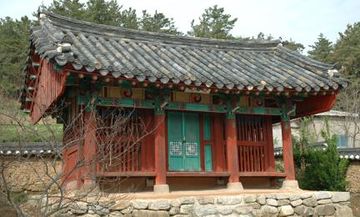"어사각"의 두 판 사이의 차이
(→영문) |
|||
| 1번째 줄: | 1번째 줄: | ||
| − | |||
{{문화유산정보 | {{문화유산정보 | ||
|사진=어사각.jpg | |사진=어사각.jpg | ||
| 30번째 줄: | 29번째 줄: | ||
'''Eosagak Commemorative Pavilion''' | '''Eosagak Commemorative Pavilion''' | ||
| − | This pavilion honors Kim Chuk and 25 other members of the Gimhae Kim | + | This pavilion honors Kim Chuk and 25 other members of the Gimhae Kim clan who sacrificed their lives to defend the country during the Japanese invasions of 1592-1598. It also honors five of their wives who, upon hearing that their husbands had died in battle, committed suicide to remain faithful to their husbands. |
| − | Upon the outbreak of the Japanese invasions, Kim Chuk, despite being 80 years old, raised a civilian army together with his brothers, cousins, sons, nephews, and grandsons. Together, they all died fighting against the Japanese invaders. In 1605, to honor their patriotic loyalty, King Seonjo (r. 1567-1608) bestowed them the title of meritorious subjects and issued them certificates stamped with the royal seal. In 1749, King Yeongjo (r. 1724-1776) bestowed them this pavilion to house the certificates. Thus, the pavilion came to be known as Eosagak, meaning | + | Upon the outbreak of the Japanese invasions, Kim Chuk, despite being 80 years old, raised a civilian army together with his brothers, cousins, sons, nephews, and grandsons. Together, they all died fighting against the Japanese invaders. In 1605, to honor their patriotic loyalty, King Seonjo (r. 1567-1608) bestowed them the title of meritorious subjects and issued them certificates stamped with the royal seal. In 1749, King Yeongjo (r. 1724-1776) bestowed them this pavilion to house the certificates. Thus, the pavilion came to be known as Eosagak, meaning “pavilion bestowed by the king.” Since then, the pavilion has undergone several renovations. |
===영문 해설 내용=== | ===영문 해설 내용=== | ||
| − | 이 건물은 임진왜란과 정유재란 때 전라도 지역에서 순국한 김축 등 김해김씨 문중의 인물 25명과, 남편의 전사 소식을 듣고 순절한 부인 | + | 이 건물은 임진왜란과 정유재란 때 전라도 지역에서 순국한 김축 등 김해김씨 문중의 인물 25명과, 남편의 전사 소식을 듣고 순절한 부인 5명을 기리기 위해 세워졌다. |
| − | 김축은 임진왜란 당시 80세의 고령임에도 불구하고 형제, 사촌, 아들, 조카, 손자들과 함께 의병을 일으켰고, 왜적과 싸우다가 일족들과 함께 순절하였다. 조선 선조(재위 1567-1608)는 1605년 이들의 충절을 기리고자 공신의 칭호를 하사하였고, 왕의 옥새가 찍힌 공신녹권을 내렸다. 1749년에는 영조(재위 1724-1776)가 전각을 하사하였고, 이곳에 공신녹권을 보관하도록 하였다. 이후 여러 차례의 중수를 거쳤다. | + | 김축은 임진왜란 당시 80세의 고령임에도 불구하고 형제, 사촌, 아들, 조카, 손자들과 함께 의병을 일으켰고, 왜적과 싸우다가 일족들과 함께 순절하였다. 조선 선조(재위 1567-1608)는 1605년 이들의 충절을 기리고자 공신의 칭호를 하사하였고, 왕의 옥새가 찍힌 공신녹권을 내렸다. 1749년에는 영조(재위 1724-1776)가 전각을 하사하였고, 이곳에 공신녹권을 보관하도록 하였다. 왕명에 의해 지어진 건물이기 때문에 “왕이 하사한 집”이라는 뜻의 ‘어사각’이라고 불린다. 이후 여러 차례의 중수를 거쳤다. |
=='''참고자료'''== | =='''참고자료'''== | ||
2020년 9월 14일 (월) 12:24 기준 최신판
| 어사각 Eosagak Commemorative Pavilion |
|
 어사각, 국가문화유산포털, 문화재청. |
|
| 대표명칭 | 어사각 |
|---|---|
| 영문명칭 | Eosagak Commemorative Pavilion |
| 한자 | 御賜閣 |
| 주소 | 전라북도 고창군 고창읍 모양성로 76 (교촌리) |
| 지정번호 | 전라북도 문화재자료 제109호 |
| 지정일 | 1985년 8월 14일 |
| 분류 | 유적건조물/인물사건/인물기념/사우 |
| 시대 | 조선시대 |
| 수량/면적 | 1동 |
| 웹사이트 | 어사각, 국가문화유산포털, 문화재청. |
|
|
|
해설문
국문
‘어사각’은 조선 시대에 왕이 내린 크고 높게 지은 집을 말하며, 정려각이라고도 한다. 정려각은 충신, 효자, 효부, 열녀 등을 기리기 위해서 정려 받은 사람의 이름과 행한 일 등을 기록한 나무판이나 비석 등을 세우고, 지방의 관리로 하여금 보호하게 하였다.
고창의 ‘어사각’은 왕명에 따라 지었다 하여 어사각이라고 한다. 임진왜란과 정유재란 당시 호남에서 전사한 김해 김씨 삼현파 김극일의 후손 25명과 남편의 전사 소식을 듣고 순절한 부인 5명의 넋을 기리기 위해 세웠다. 1605년에 이들의 충의를 기리고자 선조 임금이 ‘선무원종공신’을 하사하고, 옥쇄가 찍힌 공훈록 『단서철권』이라는 책을 내렸다. 1749년에는 영조 임금의 명으로 ‘각’을 하사하여 ‘어사각’이 되었다. 어사각에는 『단서철권』이 보존되어 있다. 일반적으로 정려각은 단칸 팔작지붕의 화려한 집이나, 고창 어사각은 솟을대문과 3칸의 맞배지붕으로 간략함과 검소함이 남다르다.
영문
Eosagak Commemorative Pavilion
This pavilion honors Kim Chuk and 25 other members of the Gimhae Kim clan who sacrificed their lives to defend the country during the Japanese invasions of 1592-1598. It also honors five of their wives who, upon hearing that their husbands had died in battle, committed suicide to remain faithful to their husbands.
Upon the outbreak of the Japanese invasions, Kim Chuk, despite being 80 years old, raised a civilian army together with his brothers, cousins, sons, nephews, and grandsons. Together, they all died fighting against the Japanese invaders. In 1605, to honor their patriotic loyalty, King Seonjo (r. 1567-1608) bestowed them the title of meritorious subjects and issued them certificates stamped with the royal seal. In 1749, King Yeongjo (r. 1724-1776) bestowed them this pavilion to house the certificates. Thus, the pavilion came to be known as Eosagak, meaning “pavilion bestowed by the king.” Since then, the pavilion has undergone several renovations.
영문 해설 내용
이 건물은 임진왜란과 정유재란 때 전라도 지역에서 순국한 김축 등 김해김씨 문중의 인물 25명과, 남편의 전사 소식을 듣고 순절한 부인 5명을 기리기 위해 세워졌다.
김축은 임진왜란 당시 80세의 고령임에도 불구하고 형제, 사촌, 아들, 조카, 손자들과 함께 의병을 일으켰고, 왜적과 싸우다가 일족들과 함께 순절하였다. 조선 선조(재위 1567-1608)는 1605년 이들의 충절을 기리고자 공신의 칭호를 하사하였고, 왕의 옥새가 찍힌 공신녹권을 내렸다. 1749년에는 영조(재위 1724-1776)가 전각을 하사하였고, 이곳에 공신녹권을 보관하도록 하였다. 왕명에 의해 지어진 건물이기 때문에 “왕이 하사한 집”이라는 뜻의 ‘어사각’이라고 불린다. 이후 여러 차례의 중수를 거쳤다.
참고자료
- 쏠쏠한 일상, 네이버 블로그 https://m.blog.naver.com/PostView.nhn?blogId=jcjkks&logNo=220991605844&categoryNo=0&proxyReferer=&proxyReferer=https:%2F%2Fwww.google.com%2F -> 내부 구조, 중수 기록, 후손 25인에 대한 정보 상세히 설명
- 디지털고창문화대전 http://gochang.grandculture.net/Contents?local=gochang&dataType=01&contents_id=GC02801193 -> 김축, 김극일, 김유신 등 ‘김해 김씨 문중 후손’의 정보 확인 가능